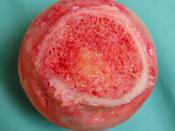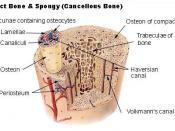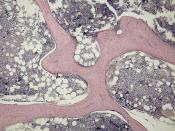The skeletal system is made up mostly of bone it also consists of tendons, ligaments and cartilage, which are arranged into a solid, rigid, structure that supports and protects our body. Bones develop during our lifetime, causing growth and change in appearance. The skeleton is necessary for survival. The skeletal structure is divided into two parts, the axial skeleton and the appendicular skeleton. The axial skeleton includes the skull, vertebral column and the thoracic cage. The appendicular skeleton includes the bones of the upper extremities, lower extremities, shoulder and pelvic bones. There are five main types of bones: long, short, flat, irregular and sesamoid. Long bones are longer than they are wide. Examples include the humerus and femur. Short bones are usually small and "roughly cube shaped with vertical and horizontal dimensions approximately equal." (Applegate) Short bone examples include the phalanges and metacarpals. Flat bones are flattened, thin and usually curved; they make up most of the skull and ribs.
Irregular bones are varied in shape and size and "tend to be more specialized in their location." (Shierdan) The vertebrae and some bones of the skull are irregular bones. Sesamoid bones function as pulleys to guide tendons during movement and are usually a small mass of bone that forms in high-pressure areas where extra strength is needed (e.g. the patella).
The skeletal system not only includes bones but also tendons, which connect muscles to bone, and ligaments, which connect bone to bone, and cartilage. Cartilage "both resembles and differs from bone." ( Marieb ) Cartilage is much more flexible than bone. The two main types of cartilage are hyaline cartilage and fibrocartilage. Hyaline cartilage is glass like in appearance and mostly coats the ends of bone providing a smooth gliding movement at the joints. Fibrocartilage contains collagen, which gives...


